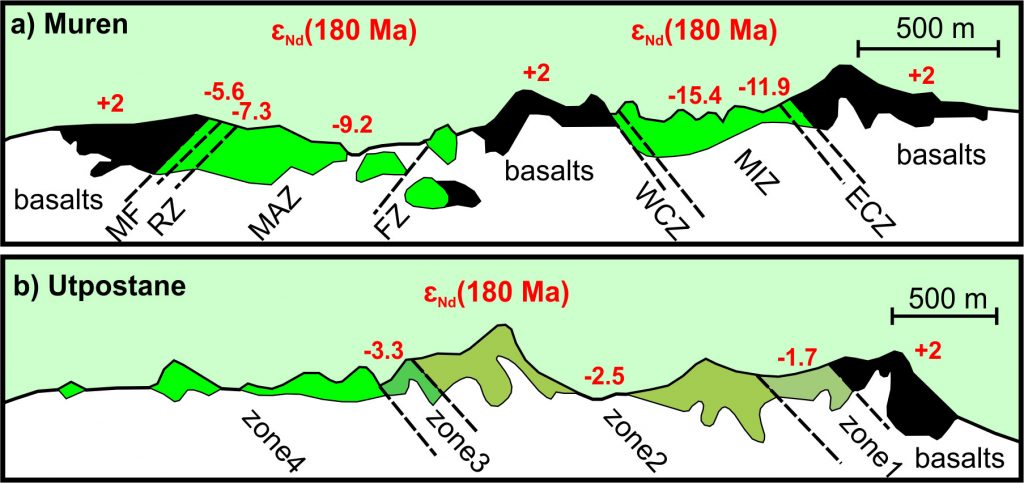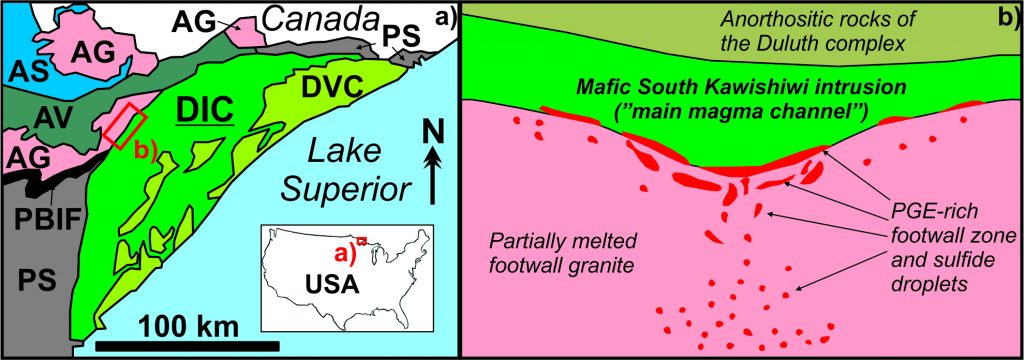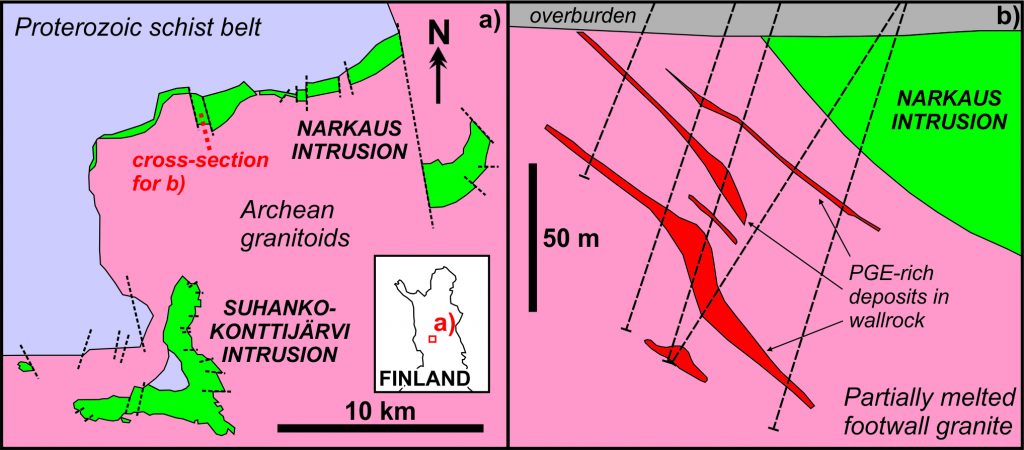This project will apply the energy-constrained assimilation-fractional crystallization models to three preliminary case studies representing different kind of intrusive complexes (see map here). Additional case studies are very likely. There probably will not be a need to collect samples from the field, there is enough material for this project stored in collections and drill core archives.
Case study I: Utpostane and Muren intrusions, Karoo large igneous province, Antarctica
The ~180-million-year old Utpostane and Muren gabbroic intrusions are found in contact with continental flood basalts that belong to the Jurassic Karoo large igneous province. Geochemical evidence suggests that the magmas were contaminated in a two-stage process, first one involving the contamination of the magma with the underlying Precambrian basement, and the second one involving contamination with the surrounding flood basalts (Vuori, 2004; Luttinen et al., 2015; A.V. Luttinen, pers comm.). Interestingly, the gabbros are less radiogenic (in terms of Nd and Sr isotopes) towards the contacts with the present wallrock (basalt). Given that Dr. Heinonen has previous experience of the related geological environment and the intrusions are smaller and less complex than the other locations, these intrusions will provide an excellent first case study for MCS in this project.

Cross-sections of the a) Muren and b) Utpostane mafic intrusions that belong to the ~180 Ma Karoo LIP. Abbreviations for the West-Muren intrusion: MF = marginal felsic unit, RZ = roof zone, MAZ = main zone. Abbreviations for the East-Muren intrusion: WCZ = western contact zone, MIZ = middle zone, ECZ = eastern contact zone. The illustration and isotopic data for the gabbros after Vuori (2004) and isotopic data for the flood basalts after Luttinen (2000).
Case study II: Duluth Igneous Complex, Minnesota, USA
The 1100-million-year old Duluth Igneous Complex is one of the largest magmatic Cu-Ni- and PGE-hosting intrusive complexes in the world. It is part of the Mid-continent rift and covers 5700 km2 west of Lake Superior. Interaction between footwall and mafic intrusion is regarded as one of the most important factors in the formation of the basal mineralization zones (e.g., Ripley and Al-Jassar, 1987; Benkó et al., 2015), but modeling of the interaction of partial melts from the Archean footwall with the mafic-ultramafic melts has not been performed. Furthermore, important source for the sulfur has been suggested to be the sulfide-rich metasedimentary formations also found in the contact of the igneous complex (e.g., Ripley and Al-Jassar, 1987; Queffurus and Barnes, 2014). MCS modeling will greatly improve the understanding of these contamination processes.

In a), 1100 Ma Duluth Igneous Complex (DIC) and geology of northern Minnesota (DVC = Duluth-related volcanic rocks; PS = Proterozoic metasediments; PBIF = Proterozoic banded iron formations; AS = Archean metasediments; AV = Archean metavolcanic rocks; AG = Archean granitoids). In b), cross-section of South Kawishiwi intrusion (approximate location indicated in a) and its PGE-rich contact zone in partially melted Archean granite. After Minnesota Geological Survey and Dean M. Peterson (Duluth Metals Ltd.).
Case study III: Layered intrusions of the Fennoscandian LIP, northern Finland
Fennoscandia is one the most notable mining regions in Europe, with important potential for new profitable discoveries. The Paleoproterozoic (~2440-million-year old) layered intrusions as part of the Fennoscandian large igneous province are found as a roughly E-W trending, 300-km-long belt in northern Finland. These intrusions are known to host all mineralization types characteristic of layered intrusions globally, including magmatic Cu-Ni sulphide, and PGE deposits similar to those found in Duluth (Iljina and Hanski, 2005). The contact zones with the footwall Archaean rocks are important hosts for magmatic sulphide ores and show modification in composition due to various degrees of magma-country rock interaction. Importantly, the highest known primary PGE concentrations in Fennoscandia are connected to these zones and related areas in the country rocks (Andersen et al., 2006). Localization of those highly needed and valuable ores needs better understanding of magma-wallrock interaction.

In a), layered intrusions (Narkaus and Suhanko-Konttijärvi) in northern Finland that belong to the Paleoproterozoic (~2440 Ma) Fennoscandian LIP. Stippled lines indicate faults. In b), cross-section of Narkaus intrusion (location of the cross-section indicated in a). Stippled lines indicate drill holes. After Iljina and Hanski (2005).
NOTE: In case everything goes smoothly and as planned (and/or we receive additional funding), it is possible to include additional case studies. There is a myriad of intrusive complexes, the understanding of which could greatly benefit from the use MCS.

